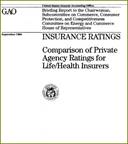Cryptocurrency Ratings Reveal Big Risks and Major Opportunities
Cryptocurrencies hold great promise for the future.
They can revolutionize money, infusing discipline into monetary policy.
Their underlying technology can help create a new kind of internet that’s fully protected from security breaches or cyberattacks.
And they offer investors some of the most amazing profit opportunities we’ve ever seen.
Unfortunately, the crypto space also has a dark side. It suffers from lax standards, murky operators, marketing hype, and periodic market crashes. It desperately needs the clarity that only robust, impartial ratings can provide.
Weiss Ratings is the world’s first financial rating agency to cover cryptocurrencies and bring that benefit to investors — to help avoid the hype, while identifying the few that truly merit consideration.
Overall, we rate about 55,000 institutions and investments. But unlike the Big Three rating agencies, we never accept compensation from issuers. Our revenues are derived strictly from investors or consumers.
This strict independence helps explain why our ratings have sometimes been the target of bitter criticism, but also the subject of accolades.
For example, in the late 1980s, we issued the first independent ratings on insurance companies, including low grades for Executive Life, Mutual Benefit Life and others.
They responded with outrage, and their lobbying organization, the American Council of Life Insurers (ACLI), mounted a broad press campaign in an attempt to discredit our ratings. But later, the insurers we warned about went bankrupt, trapping six million policyholders.
As the crisis unfolded, we were called to testify about the causes before the House Subcommittee on Commerce, Consumer and Competitiveness. The chairwoman then asked the Government Accountability Office (GAO) to compare our ratings to those of other ratings agencies.
 |
| To read GAO report, click here. |
After two years of study, the GAO concluded that Weiss beat its closest competitor, A.M. Best, by a factor of three to one in accuracy. Moreover, Weiss issued its warnings an average of eight months earlier than Best.
What about the other rating agencies? There was no contest.
Among the six insurers that Weiss and Moody’s rated in common, Weiss was first in five out of six cases.
Among the six insurers that Weiss, S&P and Best rated in common, Weiss was first in every single case.
The brief history of our Weiss Cryptocurrency Ratings is following a similar pattern. They were launched on January 24th, with Bitcoin initially getting a C+ (“Fair”), while none merited an A (“Excellent”).
This seems to have enraged crypto lovers around the world, setting off a frenzy of criticism on social media. We even suffered a cyberattack on the eve of their release. But investors heeding our warnings could have avoided serious losses, as Bitcoin and other cryptocurrencies plunged in value.
Four Separate Weiss Ratings Indexes
The Weiss Cryptocurrency Ratings are based largely on an intelligent computer model that reviews thousands of data points with four separate indexes:
1. Investment risk, based on an analysis of recent price declines, market direction, and other factors.
2. Investment reward, based on absolute and relative returns.
3. Blockchain technology, including factors such as anonymity, monetary policy, governance, ability to improve code, energy efficiency, scaling solutions, and many others.
4. Network performance in terms of adoption, transaction speed, scalability, market penetration, network security, decentralization of block production, network capacity, developer participation, public acceptance, plus other issues.
To better explain each of these factors, we have provided an in-depth description of the many reasons why we did not give Bitcoin a higher grade. (See “The Bitcoin Rating Controversy.”)
And recently, some of these factors have improved a bit, prompting an upgrade to “B-“. (See “Why Bitcoin is not dying.”)
Still, some in the crypto world misunderstand our ratings because they expect grades that focus exclusively on the last two factors — blockchain technology and network performance.
We disagree. Our ratings are designed primarily for investors and therefore give equal consideration to investment risk and reward.
Here are some of our latest results ...
• A handful of cryptos do well in most of the categories, but none merit top scores in all four.
• For example, older cryptocurrencies, such as Bitcoin (B-) and Ethereum (C+), face challenges with speed and scalability.
• Newer cryptocurrencies, such as EOS (B-) and NEO (B-), overcome these issues with their more advanced blockchain technology, but are still mostly experimental.
• On the low end of the scale, many score poorly in at least three of our indexes. Among the lowest rated are ATMChain (D-), Auroracoin (E), Comet (E-), Electroneum (E), Expanse (E-), Gulden (D), Matchpool (E), Megacoin (E-), Novacoin (E), Quark (E-), Rise (D-), and SaluS (E-).
• All cryptocurrencies continue to suffer from extreme volatility and could fall somewhat further in price.
To help protect the public, governments in the U.S. and other countries are struggling to get a grip on how to regulate this industry, and one of their chief concerns is tokens created with Initial Coin Offering (ICOs).
Although issued with cryptocurrencies, ICO tokens are effectively securities, and most are not registered. However, it has been very difficult for regulators to have an impact because all cryptocurrencies are borderless, making it easy for operators to shift to other countries.
For example, Binance, the world’s largest crypto exchange, is bypassing Hong Kong and Tokyo regulators by moving to Malta. (To better understand how, read this post.)
Clearly, the crypto world is still in its early stages of development and adoption. For everyone’s best interests, the goal should be to provide impartial information so investors can better weigh the dangers and the future potential. If they’re willing to accept the risks, they can look forward to major profit opportunities.
Best wishes,
Martin D. Weiss and Juan M. Villaverde

